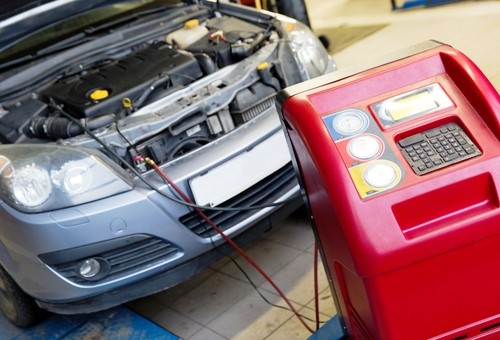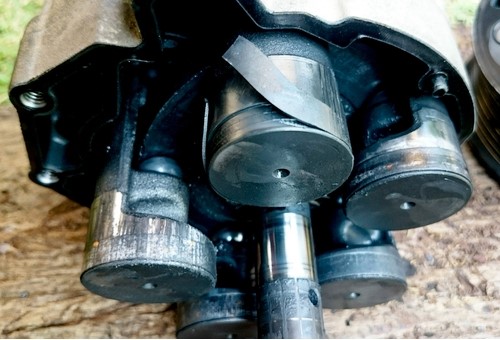
In their basic form, modern automotive A/C systems are much the same, and still work in much the same way since they came into common use in the 1950’s. Their basic operating principle still involves compressing a refrigerant gas until it liquefies, and then allowing the compressed liquid to enter a condenser where it sheds some heat. The somewhat cooler liquid then passes through a drier to remove moisture before entering the evaporator through a small orifice, which causes the liquid to evaporate when it expands into the larger volume of the evaporator’s channels. The gaseous refrigerant is then collected and returned to the compressor for the cycle to be repeated.
The process of evaporation is a complex physical one, and while we need not delve into physics of the process here, it is the rearrangement of the molecules relative to each other that make up the volume of the refrigerant (when the refrigerant changes from a liquid to a gaseous state) that causes the refrigerant to shed its heat. The guiding principle in this process is the Ideal Gas Law, which states the following- “the volume of a given amount of gas is directly proportional to the number on moles of gas, directly proportional to the temperature, and inversely proportional to the pressure”.
It should be noted though that the Ideal Gas Law is composed of several other laws, most notably Boyle’s Law, which states that ...”at [a]constant temperature, the volume of a particular mass of gas is inversely proportional to its pressure. If the pressure is doubled, the volume is halved”, and Charles’ Law, which states that ...”at [a] constant pressure, the volume of [a] fixed mass of gas is directly proportional to the Kelvin temperature [or scale] of absolute temperature. If the absolute temperature is double[d] the volume is [also] doubled.”
There are other physical laws involved as well, and although the Ideal Gas Law has severe limitations at extreme temperatures and pressures, it applies perfectly to the temperatures and pressures that obtain in automotive A/C systems. This is an important point, since the efficiency (or otherwise) of an automotive A/C system is determined solely by how all of the factors mentioned above influence the dictates of each individual law, as well as the collective dictates of the Ideal Gas Law.
As a practical matter though, all of the above apply to both old and modern automotive A/C systems equally, but the main differences between old and new systems are that-
In fact, the last point in this list is so important that most countries, including Australia, require automotive technicians to hold a dedicated qualification or certification before they are allowed to work on A/C systems. While obtaining the certifications is not unduly difficult, the problem is that many technicians, and especially technicians working at independent workshops, are not always aware of all the latest developments in automotive A/C technology.
For instance, while R-134a refrigerant is still in common use, and will be for many years, many European countries now require that car manufacturers use the more environmentally friendly R-1234yf refrigerant to limit damage to the atmosphere. This refrigerant is also increasingly being used in the USA, and today, about 40 million vehicles worldwide are using R-1234yf refrigerant in their A/C systems. Many of these vehicles are now coming out of warranty, which means that there is a good chance that you may have to deal with issues on a system running on R-1234yf refrigerant much sooner than you may have wanted.
So where is the problem in that, you may ask. You may well ask, because many of the technical aspects of A/C systems running on R-1234yf refrigerant differ from those of older systems in meaningful ways, the most important of which is the fact that-

The image above shows the type of damage that can occur when an A/C system is charged with the wrong refrigerant. However, this type of damage is seldom caused by the refrigerant itself. This usually results from either from adding lubricating oil that is incompatible with the refrigerant used, or sometimes by adding too little oil, even if the oil is compatible with the refrigerant, although the refrigerant may not be compatible with the compressor and/or overall system components.
The above is saying a lot, so let us break it down into more digestible pieces, starting with the-
Differences between R-134a and R-1234yf
Although the two refrigerants have similar thermal properties and therefore deliver similar efficiency values in automotive A/C systems, the two substances are members of two completely different chemical families. One the one hand, R-134a is mainly composed of tetrafluoroethane, and therefore belongs to the HFC family of refrigerants that also includes the propellants in many aerosol spray cans. From an environmental standpoint, R-134a has a GWP* (Global Warming Potential) rating of 1 430, which is why it is being phased out.
* The Global Warming Potential of a gas is defined as the amount of heat energy 1 ton of a gas will absorb over a set period of time (typically, 100 years) as compared to 1 ton of carbon dioxide (CO2). Thus, in the case of R-134a, 1 ton of the refrigerant will absorb 1 430 times more heat than CO2 would absorb in the same timeframe.
On the other hand, R-1234yf is composed mainly of hydrofluoroolefins that are derived from hydrogen, fluorine, and carbon, with at least one double chemical bond between all the carbon atoms. As a result, R-1234yf belongs to the HFO family of refrigerants, and although R-1234yf is classified as “mildly flammable” due to its hydrogen content, the fact is that with the exception of petrol, R-1234yf is considerably less flammable than any other fluid commonly found in engine compartments. In terms of its impact on the environment, R-1234yf has a GWP rating of only 4, which means that no special qualifications and/or certifications are required to buy, handle and store R-1234yf refrigerant.
However, it is important to note that in terms of Australia’s Ozone Protection and Synthetic Greenhouse Gas laws, all workshops and technicians that provide diagnostic, repair, and other services on automotive A/C systems are required to hold valid refrigerant handling licences if R-134a refrigerant is stored and used on the premises in any way. Nonetheless, while the above may be of some interest to some readers, we hope that the information that follows will be of interest to all readers, so let us list the following items in order of their importance, starting with saying that-
Selecting compressor oil is a minefield
One of the main reasons why R134a and R-1234yf refrigerants are not compatible is the fact that the two main classes of lubricating oils commonly used in automotive A/C systems are either not compatible with all refrigerants, or with the metals and seals used in some compressors and other components.
Unfortunately, a comprehensive treatment of A/C compressor lubricants falls outside the scope of this article, but suffice to say that while some PAG (Polyalkylene glycol) oils and some POE (poly olester-based) synthetic oils are backward compatible, this is not the case with all A/C systems and/or compressors, since both the hygroscopic qualities and viscosity of each type of oil must be considered when you are selecting a lubricant for any given A/C system or compressor.
While degradation of seals and O-rings in a system is a common issue when the wrong oil is used, more serious problems involve both the miscibility of the oil with the refrigerant, and the transportability of the oil throughout the system. In some cases, the oil may not mix with the refrigerant at all, or when it does, it may do so poorly. When this happens, all the oil may be blown into the condenser and/or evaporator where it will remain, with obvious consequences for the compressor when it is deprived of lubrication.
In other cases, the wrong oil may react with the refrigerant itself to form a highly corrosive substance that will attack all internal surfaces in the system, including those in the compressor, with equally disastrous results.
Note that since this article cannot provide specific recommendations on which oil to use with which refrigerant in which system, it is highly recommended that you do NOT add any oil to any A/C system until and unless you have obtained reliable service information from either the vehicle manufacturer, or the manufacturer of the A/C compressor. You need to know exactly which type of oil, and how much of that oil to add to the system if you want to effect a reliable repair/recharge.
You need special equipment
One of the most, if not the most important feature of R-1234yf refrigerant is that while you do not need a licence to work with it, you do need special equipment to evacuate and recharge systems that use this refrigerant, this equipment being a-
Flame proofed recovery/recycle/recharge machine
Although there is no legal requirement to recover R-1234yf refrigerant, industry best practices dictate that you do so, and that you do so only with R/R/R equipment that complies with the SAE J2843/2013 standard if the refrigerant is pure, or with recovery-only equipment that complies with the SAE J2851/2015 standard if the refrigerant is contaminated with R-134a or anything else.
Note that R/R/R equipment that is fully compliant use solenoids, relays, and other electrical components that are fully flame proofed to prevent sparking that could conceivably start fires during recovery/recharging procedures. Moreover, fully compliant equipment also largely eliminates the possibility of over or undercharging modern A/C systems that typically require refrigerant charges of only a few hundred grams.
Refrigerant analyser
This piece of equipment is particularly important for two reasons. The first is that it is a legal requirement to identify the refrigerant in R-1234yf-dependent systems, and the second is that R/R/R equipment that is intended to be used with R-1234yf will not allow an operator to recharge an A/C system if the refrigerant in the vehicle had not been identified. Moreover, compliant R/R/R equipment will also not allow an operator to evacuate or recharge an A/C system if the R-1234yf refrigerant is not at least 98% pure.
Note that refrigerant analysers can be integrated into R-1234yf-compliant R/R/R equipment, in which case the analyser must comply with the SAE J 2927 standard. External analysers must comply with the SAE J2912 standard, which states (among other things) that external analysers must be able to communicate with the R/R/R equipment via USB ports/cables.
Leak detector
Since R-1234yf refrigerant is potentially flammable and at least ten times more expensive than R-134a, it is particularly important to use leak detection equipment that is designed specifically to detect R-1234yf. Note though that electronic leak detectors are required to comply with the SAE J1913 standard, and that this standard requires manufacturers to identify themselves with a label or inscription on the equipment stating that the equipment complies with the SAE J1913 standard.
Note also that a closely related standard, SAE J1628, describes the operating procedures that must be observed when using an electronic leak detector. Amongst other things, this standard specifies the setting of sensitivity levels, and the speed at which the sensing probe must be moved past different parts of the A/C system to be effective, which brings us to the topic of-

This image shows three beakers containing the same A/C dye fluorescing at different colours under three different UV light leak detectors, and herein lays a major problem if you are still using black lights (UV lights) to detect leaks.
The problem is this: while most UV light frequencies will cause the dyes used in most R-134a-dependent systems to fluoresce, some of the dyes used in R-1234yf systems do not fluoresce at all unless a UV light with a specific frequency is used, but it gets worse. In some cases, manufacturers do not use any dye in their systems, while in other cases, some R-1234yf- compliant R/R/R machines will recognise some dyes as contaminants, and will therefore not allow that system to be evacuated or recharged.
There are two ways around these issues. One is to use a recovery-only machine to evacuate the system, and another is to use an R/R/R machine that can handle both R134a and R-1234yf refrigerants to evacuate and recharge the system. However, the problem of leak detection remains, but there are ways around that as well. One way is to use a purpose-designed UV detector that complies with the SAE J2912 standard, or if the system under repair does not contain dye, to use a high-end R/R/R machine that automatically performs leak detection tests as a part of the recharging process. Note though that automatic leak detection only confirms the presence (or absence) of a leak, and does not reveal the actual site of the leak.
Provided you have access to the above-mentioned equipment, and that the system you are working on has not been tampered with, it is unlikely that you will run into major issues during the normal course of events while working on A/C systems running on R-1234yf refrigerant, which brings us to-
While all equipment relating to R-1234yf refrigerant is designed to prevent cross-contamination of the refrigerant with other substances, realistically speaking, there is nothing that manufacturers of vehicles and A/C servicing equipment can do in the face of DIY mechanics wanting to repair/recharge the A/C systems of their own vehicles.
Essentially, the problem revolves around the fact that the black-market (“black-market”, for want of a better term) is flooded with hoses, hose fittings, gauges, and other equipment that now make it possible to connect R-1234yf-dependent A/C systems with canisters of R-134a refrigerant. Worse, though, many so-called reputable dealers fraudulently offer R/R/R equipment for sale that was designed to be used with R-134a as being fully compliant with the standards that apply to R-1234yf-related equipment.
The prime drivers behind this type of merchandise which, incidentally, has a huge uptake are a), the very high cost of R-1234yf, and, b), the great many self-proclaimed experts that post “How to” videos online showing how any DIY mechanic can “easily” adapt his R-1234yf-dependent A/C system to run on other “refrigerants”. Commonly recommended replacements for R-1234yf include anything from R-12 to R-134a, and even the gas that is intended to clean out computer keyboards.
In practical terms, all of these self-help videos have one thing in common, which is the fact that they all describe various, and infallible ways and processes of destroying A/C systems. What this means for you when you encounter an R-1234yf-dependent A/C system that had been destroyed as the result of tampering, is that instead of merely inspecting, repairing, and perhaps recharging a system, you may now have to replace the entire system, which has obvious cost implications when you are quoting on system repairs.
In this writer’s experience, there is simply no effective way to adequately evacuate and flush an R-1234yf-dependent A/C system that had been recharged with the wrong refrigerant, oil, or dye. In fact, there is nothing that you as a professional A/C technician can do about people wanting to do their A/C repairs and/or tampering either, except maybe to educate your customers on the dangers of tampering with any A/C system in any way.
Although the servicing requirements of modern automotive A/C systems appear to be somewhat intimidating to the uninitiated, it helps to bear in mind that the fundamental principles of proper A/C service have not changed to the point where you would have to learn entirely new skills.
As a matter of fact, most, if not all modern R/R/R equipment is so user friendly that they guide operators through most recovery/recharging procedures in simple to understand steps that are displayed on a screen. So if you get the basics right by using the correct refrigerants, lubricants, and dyes in the correct quantities while keeping moisture out of the system, it is extremely unlikely that you will ever run into serious issues and problems while servicing even the latest iterations of automotive A/C systems.